Cultural depictions of dinosaurs
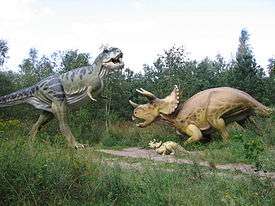

Cultural depictions of dinosaurs have been numerous since the word dinosaur was coined in 1842. The dinosaurs featured in books, films, television programs, artwork, and other media have been used for both education and entertainment. The depictions range from the realistic, as in the television documentaries of the 1990s and first decade of the 21st century, or the fantastic, as in the monster movies of the 1950s and 1960s.
The growth in interest in dinosaurs since the Dinosaur Renaissance has been accompanied by depictions made by artists working with ideas at the leading edge of dinosaur science, presenting lively dinosaurs and feathered dinosaurs as these concepts were first being considered. Cultural depictions of dinosaurs have been an important means of translating scientific discoveries to the public.
Cultural depictions have also created or reinforced misconceptions about dinosaurs and other prehistoric animals, such as inaccurately and anachronistically portraying a sort of "prehistoric world" where many kinds of extinct animals (from the Permian animal Dimetrodon to mammoths and cavemen) lived together, and dinosaurs living lives of constant combat. Other misconceptions reinforced by cultural depictions came from a scientific consensus that has now been overturned, such as the alternate usage of dinosaur to describe something that is maladapted or obsolete, or dinosaurs as slow and unintelligent.
However, most generally about the palaeontological, archaeological or naval reconstitutions, people has to be informed that a reconstitution is, by definition, in great part conjectural, because even in the rare cases of preservation in amber, tar, peat or ice, the organic material is damaged, particularly concerning its colors. Any reconstitution is thereby an « artist's view » that, in order to stay within the limits of what is allowed by researchers at the time it is made, must necessarily be inspired by other pictures already scientifically proved, for example in the specialized magazines. Even a photographer can, as an artist, modify his photography by esthetic reasons. If one does not agree this process of « conjecturally reconstituted being » (whose most impressive examples are the « real size Dinosaurs » sitting proeminently in the gardens or in the front square of various Museums, or else prehistorical Hominidae presented in dioramas by many Museums), this one will consider as « inaccurate » and/or as a « copyviol », the whole of the artist's views, of the computer-generated images, of the volumic reconstitutions, and Paleontology, Archaeology or Naval history will be deprived of all its iconography intended for general public, apart from the scientific pictures in specialized magazines, that will evade this iconographical « cleaning », possibly concerning even some great masters as Mauricio Antón, Dimitri Bogdanov, Zdeněk Burian, Heinrich Harder or Charles R. Knight.
History of depictions
Early human history to 1900: Early depictions

The classical folklorist Adrienne Mayor has proposed that the griffin of mythology is based on dinosaur skeletons found in the Gobi Desert. She noted that griffins were said to inhabit the Scythian steppes that reached from the modern Ukraine to central Asia. Mayor draws a connection to Protoceratops, a frilled dinosaur that was commonly found in the Gobi.[1] This dinosaur has features associated with griffins: they share sharp beaks, four legs, claws, similar size, and large eyes (or eye sockets in the case of the fossils), and the neck frill of Protoceratops, with large open holes, is consistent with descriptions of large ears or wings.[2] However, the palaeontologist Mark Witton notes that the suggestion ignores pre-Mycenaean accounts, and has not found favour with archaeologists including N. Wyatt and T.F. Tartaron.[3][4][5]
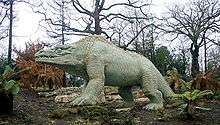
The scientific study of dinosaurs began in the 1820s of England. In 1842, Richard Owen coined the term dinosaur, which under his vision were elephantine reptiles. An ambitious scientist who used dinosaurs and other fossils to promote his beliefs, Owen was the driving force for the Crystal Palace dinosaur sculptures, the first large-scale dinosaur reconstructions that were accessible to the public (1854). These sculptures, which can still be seen today, immortalized a very early stage in the perception of dinosaurs.[6]
The Crystal Palace sculptures were successful enough that Benjamin Waterhouse Hawkins, Owen's collaborator, sold models of his sculptures[7] and planned a second exhibition, Paleozoic Museum, for Central Park in Manhattan in the late 1860s; it was never completed due to the interference of local politics and "Boss" William Marcy Tweed.[8]
In the same period, dinosaurs first appeared in popular literature, with a passing mention of an Owen-style Megalosaurus in Charles Dickens's Bleak House (1852–1853).[9] However, depictions of dinosaurs were rare in the 19th century, possibly due to incomplete knowledge. Despite the well-publicized "Bone Wars" of the late 19th century between the American palaeontologists Edward Drinker Cope and Othniel Charles Marsh, dinosaurs were not yet ingrained in culture. Marsh, although a pioneer of skeletal reconstructions, did not support putting mounted skeletons on display, and derided the Crystal Palace sculptures.[10]
1900 to the 1930s: New media
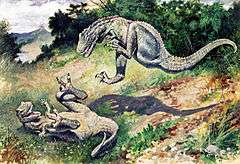
As study caught up to the wealth of new material from western North America, and venues for depictions proliferated, dinosaurs gained in popularity. The paintings of Charles R. Knight were the first influential representations of these finds. Knight worked extensively with the American Museum of Natural History and its director, Henry Fairfield Osborn, who wanted to use dinosaurs and other prehistoric animals to promote his museum[11] and his ideas on evolution.[12]
Knight's work, found in museums around the country, helped popularize dinosaurs and influenced generations of paleoartists. Interestingly, his early work showing fighting "Laelaps" (=Dryptosaurus) depicted dinosaurs as much more lively than they would be presented for much of the 20th century.[11] At the same time, improvements in casting allowed dinosaur skeletons to be reproduced and shipped across the world for display in far-flung museums, bringing them to the attention of a wider audience; Diplodocus was the first such dinosaur reproduced in this way.[13]
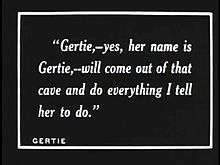
Dinosaurs began appearing in films soon after the introduction of cinema, the first being the good-natured animated Gertie the Dinosaur in 1914.[14] However, lovable dinosaurs were quickly replaced by monsters as moviemakers recognized the potential of huge frightening monsters.[15] D. W. Griffith in 1914's Brute Force provided the first example of a threatening cinematic dinosaur, a Ceratosaurus who menaced cavemen. This film enshrined the fiction that dinosaurs and early humans lived together, and set up the cliché that dinosaurs were bloodthirsty and attacked anything that moved.[7]
The now-common trope of dinosaurs existing in isolated locations in today's world appeared at the same time, with Arthur Conan Doyle's 1912 book The Lost World and the works of Edgar Rice Burroughs as pioneers. The Lost World crossed into the movies in 1925, setting heights for special effects and attempts at scientific accuracy. It is unusual, even today, for attempting to portray dinosaurs as something other than monsters that spent their lives in combat.
The stop-motion techniques of Willis O'Brien went on to bring dinosaurs to life in the 1933 film King Kong, which merged the tropes of dinosaur combat and dinosaurs in a lost world.[7] His protégé Ray Harryhausen would continue to refine this method, but most later dinosaurs movies until the advent of CGI would eschew such expensive effects for cheaper methods, such as humans in dinosaur suits, modern reptiles enlarged by cinematography, and reptiles with dinosaur decorations.[7][16] Dinosaur depictions diversified in the 1930s, spreading to newspaper comic strips in Alley Oop[16] and to advertising for Sinclair Oil.[7]
The 1930s to 1970s: Moribund dinosaurs to renaissance

The Great Depression and World War II combined to sink the study of dinosaurs into a decades-long lull.[17] Scientists considered dinosaurs a group of unrelated animals[18][19] that left no descendants, and dinosaurs were presented as stupid, slow, stuck in swamps, and doomed to extinction.[20] Scientific dinosaur artwork, primarily from Rudolph F. Zallinger and Zdeněk Burian, reflected and reinforced the conception of dinosaurs as slow and static (one artistic quirk that became commonplace in representations of Mesozoic landscapes, the presence of a volcano, was a hallmark of Zallinger's).[17] From such ideas came the alternate definition of "dinosaur" as something out of date.[21]
Films of the time typically used dinosaurs as monsters, with the added element of atomic fears in the early Cold War. Thus, The Beast from 20,000 Fathoms (1953) and Godzilla (1954; American release 1956) portray monstrous dinosaur-like prehistoric reptiles that go on rampages after being awakened by atomic bomb tests.[7][22] An alternative appears in Disney's animated Fantasia (1940), in its The Rite of Spring sequence, which attempted to portray dinosaurs with some scientific accuracy (although it has the common error of showing prehistoric animals from many different time periods living at the same time).[7]
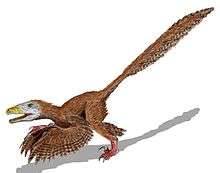
In 1956, Oliver Butterworth authored a children's book, The Enormous Egg. The book and a movie adaptation televised in 1968 by the NBC Children's Theatre tell the story of a boy who finds an enormous egg laid by a hen that hatches a baby Triceratops. The dinosaur, named Uncle Beazley, becomes too big, so the boy brings him to the Smithsonian Institution in Washington, D.C. Beazley is first kept at National Museum of Natural History, but is eventually transferred to the National Zoo's Elephant House because there is a law against stabling large animals in the District of Columbia.[23]
Dinosaurs gained a home in television in the 1960s animated sitcom The Flintstones, in another example of dinosaurs shown as coexisting with humans (for comedic effect in this case).[16] Dinosaurs also entered comic books in this period in such series as Tor and Turok, where prehistoric humans fought anachronistic dinosaurs. For those wanting more scientific accounts of dinosaurs, there were the first nontechnical dinosaur books. Ned Colbert's The Dinosaur Book (1945) was the first such book, and its status as the only such book for many years made Colbert an important figure for the coming generations of paleontologists and dinosaur enthusiasts.[7]
In the 1960s, paleontologist John Ostrom began work on the theropod Deinonychus.[24] His findings, which were expanded upon by his student Robert T. Bakker, contributed to the Dinosaur Renaissance,[25] a revolution in the study of dinosaurs. Of particular importance were a reevaluation of the origin of birds that showed them to be closely related to coelurosaurian dinosaurs,[26] reappraisal of dinosaur physiology that suggested they weren't the sluggish cold-blooded animals they'd long been assumed to be,[27] and a recognition that dinosaurs formed a natural group.[28]
Soon thereafter came new evidence on dinosaur social behavior, with nests of Maiasaura suggesting parental care.[29] These findings were reflected in the work of a new generation of paleoartists. One milestone was Sarah Landry's feathered dinosaur in Bakker's 1975 Scientific American article, Dinosaur Renaissance.[17]
Louis Paul Jonas created the first full sized dinosaur sculptures for the 1964 New York World's Fair in the "Dinoland" area, which was sponsored by the Sinclair Oil Corporation, whose logo featured a dinosaur. Jonas consulted with paleontologists Barnum Brown, Edwin H. Colbert and John Ostrom in order to create nine sculptures that were as accurate as possible. After the Fair closed, the dinosaur models toured the country on flatbed trailers as part of a company advertising campaign. Most of the statues are now on display at various museums and parks.[30][31][32]

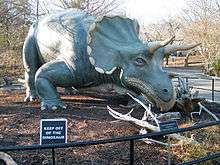
In 1967, the Sinclair Oil Corporation gave one of its dinosaurs, a fiberglass model of a Triceratops, to the Smithsonian Institution. The model, which appeared in the The Enormous Egg television movie in 1968 as Uncle Beazley, is now on display at the National Zoo in Washington, D.C. From the 1970s to 1994, the statue was located on the National Mall in front of the National Museum of Natural History.[33] (Some sources state that the Kentucky Science Center in Louisville (formerly named the "Louisville Museum of Natural History and Science" and the "Louisville Science Center") now owns the Triceratops model).[30][31]
The 1980s to the present: Dinosaurs reconsidered

The reevaluation of dinosaurs spurred public interest, with the new generation of paleoartists quick to respond. Artists such as Mark Hallett, Doug Henderson, John Gurche, Gregory S. Paul, William Stout, and Bob Walters illustrated the new findings in response to the demand.[17]
By the latter half of the 1980s and into the 1990s, other media were showing the influence of the increased popularity, with diverse depictions aimed at a variety of ages and interests.
In 1990 the Smithsonian Institution's National Museum of Natural History in Washington, D.C., featured an exhibition of dinosaur sculpture by Jim Gary that drew more visitors than any of its previous exhibits.[34] His Twentieth Century Dinosaurs, popular since the 1960s, began being featured in textbooks, encyclopedias, and videos as well as later, by the likes of National Geographic, in their publications for children in 1975.[35]
For preschoolers, there was the educational television show Barney & Friends starting in 1992; their older siblings had the 1988 animated movie The Land Before Time and its increasing line of direct to video sequels (12 by 2008). Dinosaurs, a television sitcom, parodied humans and other television shows. Of particular note is Michael Crichton's 1990 novel, Jurassic Park, the popularity of which led to a series of films and other media. The first of these, Jurassic Park, married advanced CGI[7] with advances in scientific knowledge of dinosaurs.[36] Dinosaur was the most expensive movie in 2000, but was a box-office success. The falling cost of computer-generated effects also has recently allowed the increased production of documentaries for television; the award-winning 1999 BBC series Walking with Dinosaurs, the 2001 When Dinosaurs Roamed America, the 2009 Animal Armageddon, and the 2011 Planet Dinosaur are notable examples.
In April 2016, a proposal was submitted to the Unicode committee to encode three pictures of heads of three dinosaur species considered exemplary as emoji.[37]
Public perception of dinosaurs

The popular ideals of dinosaurs have many misconceptions, reinforced by films, books, comics, television shows, and even theme parks. Typical errors include: prehistoric humans living with dinosaurs; dinosaurs as monsters that did little else but fight;[7][36] the portrayal of a kind of "prehistoric world" where all prehistoric animals are shown to exist;[7] dinosaurs as all large; dinosaurs as stupid and slow; dinosaurs as being lizard-like and all scaled (non-feathered); the inclusion of many prehistoric animals (such as Dimetrodon, ichthyosaurs, mosasaurs, pterosaurs, and plesiosaurs) as dinosaurs;[16][36] and dinosaurs as failures.
Reports in the news media of dinosaur finds and dinosaur science are often inaccurate and sensationalistic, and popular dinosaur books usually lag scientific understanding.[36] Dinosaur toys and models are often inaccurate, packaged indiscriminately with other prehistoric animals,[36] or have fictitious additions like the large sharp teeth in some rubber Triceratops toys.[7]
The pejorative use of "dinosaur" as something behind the times has been applied to people, styles, and ideas that are perceived to be out of date, and on the wane.[38] For example, members of the punk movement derided the "progressive" bands that preceded them as "dinosaur bands".[39]
However, some popular depictors have strived for accuracy and presented up-to-date information; Michael Crichton[36] and Bill Watterson (of Calvin and Hobbes)[40] are two recent examples. Paleoartists and illustrators in particular have kept up with research. Popular conceptions of dinosaurs have also been important in stimulating the interest and imagination of young people, and have been responsible for introducing many who would later become paleontologists to the field. In addition, popular depictions have the freedom to be more imaginative and speculative than technical works.[14]
Usage
The typical use of dinosaurs in popular culture has been as vicious monsters.[7] There are several distinct genres of dinosaur depictions commonly used: "lost worlds" on modern Earth; time travel stories; educational works for children;[14] prehistoric world stories (often with cavemen);[36] and dinosaurs running amok in the modern world.[16]
Appeal
The appeal of dinosaurs, as suggested by author, researcher, and dinosaur enthusiast Donald F. Glut, has multiple factors. Dinosaurs were "monsters," yet are safely extinct, allowing for vicarious thrills. They appeal to the imagination, and there are many ways to approach them intellectually. Finally, they appeal to adults nostalgic for what they enjoyed as children. Children have been particularly drawn to dinosaurs over the years.[7]
See also
- Dinosaur renaissance
- List of fictional dinosaurs
- List of films featuring dinosaurs
- List of U.S. state dinosaurs
- Paleoart
- Prehistory Park
- Reptiles in culture
- Stegosaurus in popular culture
References
- ↑ Mayor, Adrienne (2000). The First Fossil Hunters: Paleontology in Greek and Roman Times. Princeton: Princeton University Press. ISBN 0-691-05863-6.
- ↑ Dodson, Peter (1996). The Horned Dinosaurs. Princeton: Princeton University Press. pp. 225–226. ISBN 0-691-05900-4.
- ↑ Witton, Mark. "Why Protoceratops Almost Certainly Wasn't The Inspiration For Griffin Legend". Retrieved 2 July 2016.
- ↑ Tartaron, T. F. (2014). Cross-Cultural Interaction in the Greek World: Culture Contact Issues and Theories. In Encyclopedia of Global Archaeology (pp. 1804–1821). Springer New York.
- ↑ Wyatt, N. (2009). Grasping the Griffin: Identifying and Characterizing the Griffin in Egyptian and West Semitic Tradition. Journal of Ancient Egyptian Interconnections, 1(1), 29–39.
- ↑ Torrens, Hugh. "Politics and Paleontology". The Complete Dinosaur, 175–190.
- 1 2 3 4 5 6 7 8 9 10 11 12 13 14 Glut, Donald F.; Brett-Surman, Michael K. (1997). "Dinosaurs and the media". The Complete Dinosaur. Bloomington and Indianapolis: Indiana University Press. pp. 675–706. ISBN 0-253-33349-0.
- ↑ Colbert, Edwin H.; Beneker, Katharine (1959). "The Palaeozoic Museum in Central Park, or the Museum that Never Was". Curator. 2 (2): 137–150. doi:10.1111/j.2151-6952.1959.tb01403.x.
- ↑ "London. Michaelmas term lately over, and the Lord Chancellor sitting in Lincoln's Inn Hall. Implacable November weather. As much mud in the streets, as if the waters had but newly retired from the face of the earth, and it would not be wonderful to meet a Megalosaurus, forty feet long or so, waddling like an elephantine lizard up Holborne Hill." From page 1 of Dickens, Charles J.H. (1852). Bleak House, Chapter I: In Chancery. London: Bradbury & Evans.
- ↑ Dodson, Peter. The Horned Dinosaurs, 74–75.
- 1 2 Paul, Gregory S. (2000). "The Art of Charles R. Knight". In Paul, Gregory S. (ed.). The Scientific American Book of Dinosaurs. New York: St. Martin's Press. pp. 113–118. ISBN 0-312-26226-4.
- ↑ Padian, Kevin (2004). "An Agenda for Antiquity: Henry Fairfield Osborn and Vertebrate Paleontology at the American Museum of Natural History, 1890–1935 and Henry Fairfield Osborn: Race and the search for the origins of man". Journal of Vertebrate Paleontology. 24 (3): 769–771. doi:10.1671/0272-4634(2004)024[0769:AAFAHF]2.0.CO;2.
- ↑ Bakker, Robert T. (1986). The Dinosaur Heresies. New York: William Morrow. p. 203. ISBN 0-14-010055-5.
- 1 2 3 Sarjeant, William A.S. (2001). "Dinosaurs in fiction". In Tanke, Darren H.; and Carpenter, K. (eds.). Mesozoic Vertebrate Life. Bloomington and Indianapolis: Indiana University Press. pp. 504–529. ISBN 0-253-33907-3.
- ↑ Searles, Baird (1988). "Dinosaurs and others". Films of Science Fiction and Fantasy. New York: AFI Press. pp. 104–116. ISBN 0-8109-0922-7.
- 1 2 3 4 5 Lambert, David; the Diagram Group (1990). The Dinosaur Data Book. New York: Avon Books. pp. 290–301. ISBN 0-380-75896-2.
- 1 2 3 4 Paul, Gregory S. (2000). "A Quick History of Dinosaur Art". In Paul, Gregory S. (ed.). The Scientific American Book of Dinosaurs. New York: St. Martin's Press. pp. 107–112. ISBN 0-312-26226-4.
- ↑ Romer, Alfred Sherwood (1956). Osteology of the Reptiles. Chicago: University of Chicago Press. pp. 1–772. ISBN 0-89464-985-X.
- ↑ Bakker, Robert T. The Dinosaur Heresies, 447–449.
- ↑ Bakker, Robert T. The Dinosaur Heresies, 15–16.
- ↑ "Definition of dinosaur" Merriam-Webster's Online Dictionary. Accessed 26 May 2007.
- ↑ Snider, Mike (2006-08-29). "Godzilla arouses atomic terror". USA Today. Gannett Corporation. Retrieved 2007-02-21.
- ↑ Butterworth, Oliver, illustrated by Louis Darling (1956). The Enormous Egg. Boston, Massachusetts: Little, Brown and Co. ISBN 0-590-47546-0. OCLC 299175. Retrieved July 4, 2016.
(2) "About this book". The Enormous Egg by Oliver Butterworth, illustrated by Louis Darling. Scholastic Inc. 2016. Archived from the original on July 31, 2012. Retrieved July 3, 2016.At first Nate doesn't see what all the fuss is all about. All he wants is to keep his new pet. But Uncle Beazley, the dinosaur himself, just keeps getting bigger and bigger ...
(3) "NBC Children's Theatre (1963–1973): The Enormous Egg: Episode aired April 18, 1968". IMDb.com, Inc. 2008. Archived from the original on March 9, 2008. Retrieved July 3, 2016.
(4) MacIntyre, F Gwynplaine (May 28, 2003). "User Comment". NBC Children's Theatre (1963–1973): The Enormous Egg: Episode aired April 18, 1968. IMDb.com, Inc. Archived from the original on March 9, 2008. Retrieved July 3, 2016. - ↑ Ostrom, J. H. (1969). "Osteology of Deinonychus antirrhopus, an unusual theropod from the Lower Cretaceous of Montana". Peabody Museum of Natural History Bulletin. 30: 1–165. OCLC 679420.
- ↑ The term has entered into common usage after an article of the same name by paleontologist Robert T. Bakker in Scientific American, in April 1975. Examples can be found here and here.
- ↑ Ostrom, John (1974). "Archaeopteryx and the origin of flight". The Quarterly Review of Biology. 49 (1): 27. doi:10.1086/407902.
- ↑ Bakker, Robert T. (1968). "The superiority of dinosaurs". Discovery. 3 (2): 11–22.
- ↑ Bakker, Robert T.; Galton, Peter M. (1974). "Dinosaur monophyly and a new class of vertebrates". Nature. 248 (5444): 168–172. Bibcode:1974Natur.248..168B. doi:10.1038/248168a0.
- ↑ Horner, John R.; Makela, Robert (1979). "Nest of juveniles provides evidence of family-structure among dinosaurs". Nature. 282 (5736): 296–298. Bibcode:1979Natur.282..296H. doi:10.1038/282296a0.
- 1 2 "Sinclair at the New York World's Fair". 1960s. Sinclair Oil Corporation. Archived from the original on May 5, 2016. Retrieved July 4, 2016.
- 1 2 "Sinclair Dinoland: New York World's Fair 1964–65". Science Leads the Way. Frank J. Leskovitz. 2016. Archived from the original on March 5, 2016. Retrieved July 2, 2016.
- ↑
(1) "Sinclair's New York World's Fair (1964–65) "Dinoland" Pavilion". Sinclair History. Sinclair Oil Corporation. 2013. Archived from the original on May 9, 2015. Retrieved July 11, 2016.
(2) "Dinosaur Fever – Sinclair's Icon". Petroleum History Almanac. Washington, D.C.: American Oil & Gas Historical Society. 2016. Archived from the original on April 10, 2016. Retrieved July 2, 2016.
(3) "Sinclair Dinoland: New York World's Fair 1964–65". Science Leads the Way. Frank J. Leskovitz. 2016. Archived from the original on March 5, 2016. Retrieved July 2, 2016.
(4) "Ankylosaurus at HMNS: 40 Year Mystery Solved". Houston Museum of Natural Science. Retrieved August 4, 2014. - ↑ (1) Goode, James M. (1974). Uncle Beazley. The Outdoor Sculpture of Washington, D.C.: A Comprehensive Historical Guide. Washington, D.C.: Smithsonian Institution Press. p. 260. ISBN 978-0-88103-233-8. OCLC 2610663. Retrieved 2016-07-04.
This 25-foot long replica of a Triceratops ... was placed on the Mall in 1967. ...
The full-size Triceratops replica and eight other types of dinosaurs were designed by two prominent paleontologists, Dr. Barnum Brown of the American Museum of Natural History, in New York City, and Dr. John Ostrom of the Peabody Museum, in Peabody, Massachusetts. The sculptor, Louis Paul Jonas, executed these prehistoric animals in fiberglass, after the designs of Barnum and Ostrom, for the Sinclair Refining Company's Pavilion at the New York World's Fair of 1964. After the Fair closed, the nine dinosaurs, which weighed between 2 and 4 tons each, were placed on trucks and taken on a tour of the eastern United States. The Sinclair Refining Company promoted the tour for public relations and advertising purposes, since their trademark was the dinosaur. In 1967, the nine dinosaurs were given to various American museums.
This particular replica was used for the filming of The Enormous Egg, a movie made by the National Broadcasting Company for television, based on a children's book of the same name by Oliver Buttersworth. The movie features an enormous egg, out of which hatches a baby Tricerotops; the boy consults with the Smithsonian Institution which accepts Uncle Beazley for the National Zoo.
(2) "A Dinosaur at the Zoo". Art at the National Zoo. Washington, D.C.: Smithsonian National Zoological Park. Archived from the original on June 12, 2007. Retrieved July 1, 2016.
(3) "Uncle Beazley". Histories of the National Mall. Fairfax, Virginia: Roy Rosenzweig Center for History and New Media, George Mason University. Archived from the original on April 16, 2016. Retrieved July 1, 2016.For a slow-moving dinosaur, Uncle Beazley is widely traveled. Before coming to the Mall in the 1970s, his home was the Smithsonian's Anacostia Neighborhood Museum. In 1994, Uncle Beazley moved from the Mall to his current residence, the National Zoo.
- ↑ Roth, Andrew (2006-02-14). "Jim Gary". The Guardian. Retrieved 2008-08-06.
- ↑ Celeskey, Matt (2006-01-17). "Sculptor Jim Gary dies". Hairy Museum of Natural History. Retrieved 2008-08-06.
- 1 2 3 4 5 6 7 Lucas, Spencer G. (2000). "Dinosaurs in the public eye". Dinosaurs: The Textbook (3rd ed.). Boston: McGraw-Hill. pp. 247–260. ISBN 0-07-303642-0.
- ↑ Milan, Courtney (April 2, 2016). "Jurassic Emoji Proposal" (PDF). Document L2/16-072. Unicode Technical Committee. Retrieved April 13, 2016.
- ↑ "dinosaur". Dictionary.com. Lexico Publishing Group, LLC. Retrieved 2008-08-06.
- ↑ Bussy, Pascal (2004). Kraftwerk: Man, Machine, and Music (Revised Updated ed.). SAF Publishing Ltd. p. 87. ISBN 0-946719-70-5.
- ↑ Farlow, James O. and Brett-Surman, Michael K. The Complete Dinosaur, Plate 22.
Further reading
- Allen A. Debus, Diane E. Debus, "Paleoimagery: The Evolution of Dinosaurs in Art", 2002
- Allen A. Debus, "Dinosaurs in Fantastic Fiction: A Thematic Survey", ISBN 0-7864-2672-1, 2006
